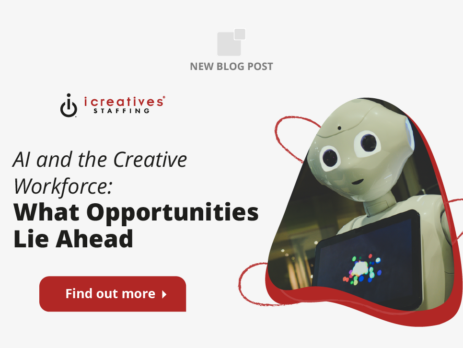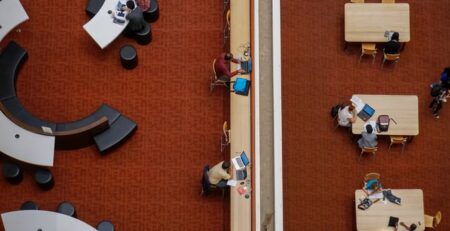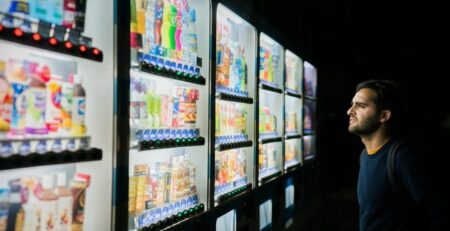AI and the Creative Workforce: What Opportunities Lie Ahead
The rise of Artificial Intelligence (AI) has sparked a revolution in various industries, and the creative workforce is no exception. As AI continues to evolve, it offers both opportunities and challenges to creative professionals. From automating mundane tasks to enhancing creative processes, AI is reshaping the way creatives work. This transformation is not just about technology; it’s about reimagining creativity itself.
AI’s integration into the creative sector is opening new avenues for innovation. Designers, writers, and artists are leveraging AI tools to push the boundaries of their work. These tools enable them to focus more on the creative aspects, leaving repetitive tasks to machines. The potential for collaboration between AI and human creativity is vast and largely untapped.
However, the rise of AI also brings concerns about job displacement. While AI can handle certain tasks, it cannot replicate human creativity and emotional intelligence. This presents a challenge for professionals to adapt and find new ways to integrate AI into their workflows. The key is to view AI as a partner rather than a competitor.
As the creative industry navigates this technological shift, education and training become crucial. Upskilling and reskilling are essential for professionals to stay relevant. By embracing continuous learning, creatives can harness the power of AI to enhance their work and open new career opportunities.
In this article, we will explore the opportunities and challenges AI presents to the creative workforce. We will delve into how AI is transforming creative roles, the skills needed to thrive, and the future landscape of creativity in an AI-driven world.
Most Asked Questions
- How is AI transforming creative roles?
- What skills are needed to thrive in an AI-driven world?
- How can creatives adapt to AI integration?
- What challenges does AI present to creatives?
- How will education and training evolve in the AI era?

How is AI transforming creative roles?
AI is revolutionizing creative roles by automating repetitive tasks and enhancing creative processes. For instance, AI-powered design tools can generate multiple design variations quickly, allowing designers to experiment with different concepts without starting from scratch. This not only saves time but also fosters innovation.
In the field of writing, AI tools can assist in generating content ideas, drafting articles, and even editing. While AI can produce text, it lacks the ability to infuse content with human emotion and nuance. This highlights the importance of human oversight in maintaining the quality and authenticity of creative work.
AI is also making waves in music production. AI algorithms can compose music, analyze trends, and even suggest improvements. Musicians can use these tools to explore new genres and styles, expanding their creative horizons. However, the emotional depth and cultural context in music remain uniquely human attributes.
One of the significant transformations AI brings is in the realm of visual arts. AI can generate art, analyze patterns, and even restore damaged artworks. Artists are using AI to create pieces that blend human creativity with machine precision, resulting in unique and innovative art forms.
AI’s role in creative roles extends to marketing and advertising as well. AI can analyze consumer behavior, predict trends, and personalize content. This allows marketers to craft campaigns that resonate with audiences on a deeper level, enhancing engagement and brand loyalty.
While AI is transforming creative roles, it is crucial to recognize its limitations. AI lacks the ability to understand cultural nuances, emotional depth, and ethical considerations. These aspects require human judgment and creativity, emphasizing the need for collaboration between AI and human creatives.
The integration of AI into creative roles is not about replacing humans but augmenting their capabilities. By automating mundane tasks, AI frees up time for creatives to focus on strategic and innovative aspects of their work. This partnership between AI and humans has the potential to redefine creativity itself.
As AI continues to evolve, creative roles will need to adapt. Professionals must embrace AI as a tool that enhances their work rather than a threat to their jobs. By leveraging AI’s capabilities, creatives can push the boundaries of their fields and create work that resonates with audiences worldwide.
To successfully integrate AI into creative roles, organizations must foster a culture of innovation and experimentation. Encouraging collaboration between AI experts and creative professionals can lead to groundbreaking advancements in the industry.
In conclusion, AI is transforming creative roles by automating tasks, enhancing processes, and opening new avenues for innovation. The future of creativity lies in the collaboration between AI and human ingenuity, paving the way for a new era of creative expression.
What skills are needed to thrive in an AI-driven world?
Thriving in an AI-driven world requires a blend of technical and creative skills. As AI becomes more integrated into creative industries, professionals must adapt to new technologies and methodologies. Here are some essential skills needed to succeed:
1. Technical Proficiency: Understanding AI tools and technologies is crucial. Creatives should familiarize themselves with AI software and platforms relevant to their field. This includes learning how to use AI for design, writing, music production, and more.
2. Data Literacy: AI relies heavily on data. Creatives must develop the ability to analyze and interpret data to make informed decisions. This skill is essential for understanding consumer behavior, predicting trends, and personalizing content.
3. Creativity and Innovation: While AI can automate tasks, creativity remains a uniquely human trait. Professionals should focus on enhancing their creative thinking and problem-solving abilities. This involves exploring new ideas, experimenting with different approaches, and pushing the boundaries of their work.
4. Emotional Intelligence: AI lacks the ability to understand emotions and cultural nuances. Creatives must possess strong emotional intelligence to connect with audiences on a deeper level. This skill is vital for crafting content that resonates with people and evokes emotions.
5. Adaptability: The AI landscape is constantly evolving. Professionals must be adaptable and open to change. This involves staying updated with the latest AI trends, technologies, and best practices. Embracing continuous learning is key to staying relevant in an AI-driven world.
6. Collaboration: AI integration requires collaboration between different teams and disciplines. Creatives should develop strong communication and teamwork skills to work effectively with AI experts, data scientists, and other professionals.
7. Ethical Awareness: AI raises ethical considerations, such as data privacy and bias. Creatives must be aware of these issues and ensure their work aligns with ethical standards. This involves understanding the implications of AI and making responsible decisions.
8. Strategic Thinking: AI can provide valuable insights, but strategic thinking is needed to interpret and apply these insights effectively. Creatives should focus on developing their strategic planning skills to make informed decisions and achieve their goals.
9. Resilience: The integration of AI may lead to challenges and setbacks. Professionals must develop resilience to overcome obstacles and continue pushing forward. This involves maintaining a positive mindset and learning from failures.
In conclusion, thriving in an AI-driven world requires a combination of technical proficiency, creativity, emotional intelligence, and adaptability. By developing these skills, creatives can harness the power of AI to enhance their work and open new opportunities.
How can creatives adapt to AI integration?
Adapting to AI integration requires a proactive approach and a willingness to embrace change. Creatives can take several steps to effectively integrate AI into their workflows and enhance their work:
1. Embrace Continuous Learning: Staying updated with the latest AI trends and technologies is crucial. Creatives should invest in learning opportunities, such as online courses, workshops, and seminars, to enhance their skills and knowledge.
2. Experiment with AI Tools: Creatives should explore AI tools relevant to their field and experiment with their capabilities. This involves testing different tools, understanding their features, and identifying how they can enhance creative processes.
3. Collaborate with AI Experts: Collaboration is key to successful AI integration. Creatives should work closely with AI experts, data scientists, and technologists to understand AI’s potential and limitations. This collaboration can lead to innovative solutions and advancements.
4. Focus on Creativity: While AI can automate tasks, creativity remains a uniquely human trait. Creatives should focus on enhancing their creative thinking and problem-solving abilities. This involves exploring new ideas, experimenting with different approaches, and pushing the boundaries of their work.
5. Develop Data Literacy: Understanding data is essential for leveraging AI effectively. Creatives should develop data literacy skills to analyze and interpret data, make informed decisions, and personalize content for their audiences.
6. Foster a Culture of Innovation: Organizations should foster a culture of innovation and experimentation. Encouraging collaboration between AI experts and creative professionals can lead to groundbreaking advancements in the industry.
7. Stay Ethical: AI raises ethical considerations, such as data privacy and bias. Creatives must be aware of these issues and ensure their work aligns with ethical standards. This involves understanding the implications of AI and making responsible decisions.
8. Adapt to Change: The AI landscape is constantly evolving. Creatives must be adaptable and open to change. This involves staying updated with the latest AI trends, technologies, and best practices. Embracing continuous learning is key to staying relevant in an AI-driven world.
9. Leverage AI for Personalization: AI can provide valuable insights into consumer behavior and preferences. Creatives can use these insights to personalize content and create campaigns that resonate with audiences on a deeper level.
In conclusion, adapting to AI integration requires a proactive approach, continuous learning, and a focus on creativity and collaboration. By embracing AI as a tool that enhances their work, creatives can push the boundaries of their fields and create work that resonates with audiences worldwide.
What challenges does AI present to creatives?
While AI presents numerous opportunities, it also poses several challenges to creatives. Understanding these challenges is crucial for professionals to navigate the evolving landscape effectively:
1. Job Displacement: One of the primary concerns is the potential for job displacement. As AI automates tasks, some roles may become obsolete. Creatives must adapt by upskilling and finding new ways to integrate AI into their workflows.
2. Loss of Creativity: AI can automate repetitive tasks, but it cannot replicate human creativity. There is a risk that over-reliance on AI may lead to a loss of creativity and originality in creative work.
3. Ethical Concerns: AI raises ethical considerations, such as data privacy, bias, and accountability. Creatives must be aware of these issues and ensure their work aligns with ethical standards.
4. Cultural Nuances: AI lacks the ability to understand cultural nuances and emotional depth. This presents a challenge for creatives to ensure their work resonates with diverse audiences.
5. Dependence on Technology: Over-reliance on AI tools may lead to a dependence on technology, reducing the need for human input and judgment. Creatives must strike a balance between leveraging AI and maintaining human oversight.
6. Data Security: AI relies heavily on data, raising concerns about data security and privacy. Creatives must ensure that data is handled responsibly and securely.
7. Skill Gap: The integration of AI requires new skills and knowledge. Creatives may face a skill gap if they do not adapt to new technologies and methodologies.
8. Resistance to Change: The rapid pace of AI development may lead to resistance to change among professionals. Creatives must be open to new ideas and embrace innovation to stay relevant.
9. Quality Control: While AI can automate tasks, it may not always produce high-quality results. Creatives must maintain quality control and ensure that AI-generated work meets their standards.
In conclusion, AI presents challenges such as job displacement, ethical concerns, and cultural nuances. By addressing these challenges and embracing AI as a tool that enhances their work, creatives can navigate the evolving landscape effectively.
How will education and training evolve in the AI era?
Education and training are crucial for preparing the creative workforce for the AI era. As AI continues to transform industries, educational institutions and training programs must evolve to meet the changing needs of professionals:
1. Emphasis on Technical Skills: Education and training programs will need to emphasize technical skills, such as programming, data analysis, and AI tool proficiency. This will ensure that professionals are equipped to work with AI technologies.
2. Integration of AI in Curriculum: AI-related courses and modules should be integrated into creative programs. This will provide students with a comprehensive understanding of AI’s potential and limitations in their field.
3. Focus on Creativity and Innovation: While technical skills are essential, creativity and innovation remain crucial. Education programs should encourage creative thinking, problem-solving, and experimentation to foster innovation.
4. Continuous Learning Opportunities: The rapid pace of AI development requires continuous learning. Educational institutions should offer opportunities for professionals to upskill and reskill throughout their careers.
5. Collaboration with Industry: Collaboration between educational institutions and industry is vital. This ensures that training programs align with industry needs and provide students with relevant skills and knowledge.
6. Ethical Training: AI raises ethical considerations, such as data privacy and bias. Education programs should include ethical training to ensure that professionals make responsible decisions in their work.
7. Interdisciplinary Approach: AI integration requires collaboration between different disciplines. Education programs should adopt an interdisciplinary approach, encouraging students to work with peers from various fields.
8. Real-World Experience: Hands-on experience is crucial for understanding AI’s practical applications. Education programs should provide opportunities for students to work on real-world projects and gain practical experience.
9. Adaptability and Resilience: Education programs should focus on developing adaptability and resilience in students. This will prepare them to navigate the evolving landscape and embrace change.
In conclusion, education and training must evolve to prepare the creative workforce for the AI era. By emphasizing technical skills, creativity, and ethical training, educational institutions can equip professionals to thrive in an AI-driven world.
Conclusion
The integration of AI into the creative workforce presents both opportunities and challenges. As AI continues to evolve, it is reshaping creative roles, enhancing processes, and opening new avenues for innovation. However, it also raises concerns about job displacement, ethical considerations, and cultural nuances.
To thrive in an AI-driven world, creatives must develop a blend of technical and creative skills. This includes understanding AI tools, analyzing data, and enhancing creativity and emotional intelligence. By embracing continuous learning and collaboration, professionals can harness the power of AI to enhance their work and open new opportunities.
Adapting to AI integration requires a proactive approach and a willingness to embrace change. Creatives can take several steps to effectively integrate AI into their workflows, including experimenting with AI tools, collaborating with AI experts, and focusing on creativity and innovation.
Education and training play a crucial role in preparing the creative workforce for the AI era. By emphasizing technical skills, creativity, and ethical training, educational institutions can equip professionals to navigate the evolving landscape and embrace AI as a tool that enhances their work.
As the creative industry navigates this technological shift, it is essential to view AI as a partner rather than a competitor. The future of creativity lies in the collaboration between AI and human ingenuity, paving the way for a new era of creative expression.
By addressing the challenges and embracing the opportunities AI presents, the creative workforce can redefine creativity itself and create work that resonates with audiences worldwide.
In today’s competitive market, finding the right creative and marketing expert can be a challenge. But with icreatives, you’re in experienced hands. With 37 years in staffing and a track record of matching more than 10,000 employees to over 1,000 companies worldwide, we know how to connect you with the best. Plus, you only pay if you hire—there’s no risk, only results. Ready to find your perfect creative or marketing expert? HIRE WITH ICREATIVES today!












